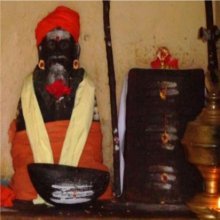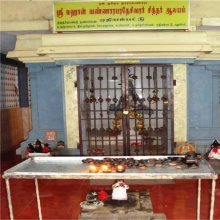Shrine: 2 definitions
Introduction:
Shrine means something in the history of ancient India. If you want to know the exact meaning, history, etymology or English translation of this term then check out the descriptions on this page. Add your comment or reference to a book if you want to contribute to this summary article.
Images (photo gallery)
(+152 more images available)
India history and geography
Source: Suomen Antropologi: Sacred Trees among the Tamil people of South IndiaThe shrines of the guardian deities are commonly situated at the entrance of a village. At the core of a shrine there is usually a sacred tree, most often an indigenous species such as a Bodhi (Ficus religiosa), a Banyan (Ficus benghalensis), or a Neem (Azadirachta indica). If the village guardian is male, an image made of stone or clay resides under the tree, sheltered by stone walls and a roof. [...] As a visible sign, a small shrine with the image of the god or goddess, is placed at the foot of the tree which then remains the focus of attention for devotees who regularly gather for pūjās (religious ceremonies). Others just stop by for a moment of prayer when passing. However, should the deity collect a large crowd of devotees, the villagers may build the deity a temple made of concrete or other materials such as stone, clay or wood, whereupon the image of the resident god or goddess is then placed inside the temple and becomes the focus of attention for the devotees as a personification of the deity inhabiting the tree.
Source: Singhi Jain Series: Ratnaprabha-suri’s Kuvalayamala-katha (history)Shrines (of gods and goddesses of different religions) were prevalent in ancient India, as depicted in the Kathās (narrative poems) such as Uddyotanasūri in his 8th-century Kuvalayamālā (a Prakrit Campū, similar to Kāvya poetry).—Page 82.30: Here is a list of religious establishments of different denominations as mantra-jāpa-maṇḍapa, brāhmaṇa-śālā, rudra-bhavana, dhārmika-maṭha, Home of Kāpālikas, Holy platforms of Yakṣas, Nāgas etc., Brahmanical songs were sung in āvasati, Jinagṛha, Buddhavihāra or Buddhist monasteries, Shrine of goddess Kottavī, Temple of six-headed god Kārttikeya and temple of other deities.

The history of India traces the identification of countries, villages, towns and other regions of India, as well as mythology, zoology, royal dynasties, rulers, tribes, local festivities and traditions and regional languages. Ancient India enjoyed religious freedom and encourages the path of Dharma, a concept common to Buddhism, Hinduism, and Jainism.
See also (Relevant definitions)
Starts with: Shrinera.
Full-text (+1074): Parivaralaya, Jagannathakshetra, Sthanadhikara, Vimana, Devakulika, Caitya, Darshana, Ayyappa-svami, Devhara, Tunk, Karkhana, Vihara, Mahatmya, Udenacetiya, Tirtha, Dharmodaya, Varadavinayaka, Kailasanatha, Siddhakshetra, Caityagriha.
Relevant text
Search found 173 books and stories containing Shrine; (plurals include: Shrines). You can also click to the full overview containing English textual excerpts. Below are direct links for the most relevant articles:
Early Chola Temples (by S. R. Balasubrahmanyam)
Ashta Parivara Devatas < [Chapter XIII - Prasada: Component Parts]
Temples in Erumbur (Urumur) < [Chapter II - Temples of Parantaka I’s Time]
Note on the Three Oldest Rajakesari Inscriptions of Agastyesvaram < [Chapter XIII - Prasada: Component Parts]
Middle Chola Temples (by S. R. Balasubrahmanyam)
Temples in Tiruvarur < [Chapter IV - Temples of Rajendra I’s Time]
Amman Shrine < [Tanjavur/Thanjavur (Rajarajesvaram temple)]
Temples in Ambasamudram < [Chapter II - Temples of Rajaraja I’s Time]
Temples of Munnur (Historical Study) (by R. Muthuraman)
Later Chola Temples (by S. R. Balasubrahmanyam)
Temples in Mayuram < [Chapter XIV - Temples of Rajaraja III’s Time]
Temples in Suryanarkoyil < [Chapter II - Temples of Kulottunga I’s Time]
Temples in Ambar-makalam < [Chapter II - Temples of Kulottunga I’s Time]
Jainism in Odisha (Orissa) (by Ashis Ranjan Sahoo)
Jaina Antiquities in Nilagiri (Balasore) < [Chapter 3: Survey of Jaina Antiquities in Odisha]
Structural Architecture < [Chapter 4]
Monoliths (chaumukha/chaturmukha shrines) < [Chapter 4]
The Skanda Purana (by G. V. Tagare)
Section 2 - Caturaśīti-liṅga-māhātmya < [Book 5 - Āvantya-khaṇḍa]
Chapter 51 - Greatness of Ketvīśvra (Ketu-īśvra) < [Section 1 - Prabhāsa-kṣetra-māhātmya]
Chapter 87 - Greatness of Soma’s Shrine < [Section 1 - Tīrtha-māhātmya]
Related products









